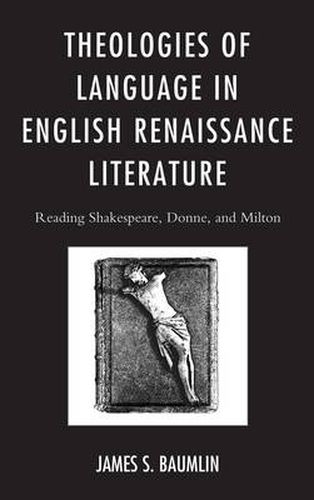Readings Newsletter
Become a Readings Member to make your shopping experience even easier.
Sign in or sign up for free!
You’re not far away from qualifying for FREE standard shipping within Australia
You’ve qualified for FREE standard shipping within Australia
The cart is loading…






This title is printed to order. This book may have been self-published. If so, we cannot guarantee the quality of the content. In the main most books will have gone through the editing process however some may not. We therefore suggest that you be aware of this before ordering this book. If in doubt check either the author or publisher’s details as we are unable to accept any returns unless they are faulty. Please contact us if you have any questions.
James S. Baumlin’s Theologies of Language in English Renaissance Literature offers a revisionist history of discourse, taking Shakespeare, Donne, and Milton as its touchstones. Their works mark stages in die Entzauberung or disenchantment, as Max Weber has termed it: that is, in the elimination of magic from the world. Shakespeare’s Hamlet questions the word-magic associated with medieval Catholicism; Donne’s love lyrics ironize the sacramental gestures of their poetic-priestly speakers; more radical still, Milton’s major poems and polemical prose empty language of sacral power, repudiating human persuasion entirely over matters of saving faith.
Baumlin describes four archetypes of historical rhetoric: sophism, skepticism, incarnationism, and transcendence. Undergirding the age’s competing theologies, each makes unique assumptions regarding the powers of language (both communicative and performative); the nature of being (including transcendent being or deity); the structure of the psyche (whether sin-weakened or self-sufficient); and the capacities of human knowing (whether certain knowledge is communicable-or even possible). Working within divergent theologies of language, the poets here studied take theological controversies as explicit themes.
The crisis of Hamlet begins not in a king’s murder simply, but in his dying without benefit of the sacraments. As if compensating for their loss, young Hamlet minister[s] to Gertrude while acting as scourge to Claudius. Alternating between soul-cursing and soul-curing, Hamlet plays sorcerer and priest indiscriminately.
Appropriating the speech-acts of Catholic sacramentalism, Donne’s lyrics describe a private religion of Love, over which the poet-lover presides as officiant. Or rather, some lyrics present him as Love’s Priest, there being as many personae as there are theologies of language. Beyond Love’s Priest, Baumlin describes three such personae: Love’s Apostate, Love’s Atheist, and Love’s Reformer.
Focusing on Lycidas and De Doctrina Christiana, Baumlin outlines Milton’s plerophoristic rhetoric of certitude. Such texts as these explore the problematic status of preaching. (Can human eloquence contribute to salvation?) They explore competing definitions (Aristotelian vs. Pauline) of pistis-meaning alternatively (religious) faith and (rhetorical) persuasion. And they invoke conflicting typologies (classical vs. Hebraic) of authorial ethos.
Baumlin’s study ends with a glance at the Restoration and Royal Society’s final disenchantment or secularization of discourse.
$9.00 standard shipping within Australia
FREE standard shipping within Australia for orders over $100.00
Express & International shipping calculated at checkout
This title is printed to order. This book may have been self-published. If so, we cannot guarantee the quality of the content. In the main most books will have gone through the editing process however some may not. We therefore suggest that you be aware of this before ordering this book. If in doubt check either the author or publisher’s details as we are unable to accept any returns unless they are faulty. Please contact us if you have any questions.
James S. Baumlin’s Theologies of Language in English Renaissance Literature offers a revisionist history of discourse, taking Shakespeare, Donne, and Milton as its touchstones. Their works mark stages in die Entzauberung or disenchantment, as Max Weber has termed it: that is, in the elimination of magic from the world. Shakespeare’s Hamlet questions the word-magic associated with medieval Catholicism; Donne’s love lyrics ironize the sacramental gestures of their poetic-priestly speakers; more radical still, Milton’s major poems and polemical prose empty language of sacral power, repudiating human persuasion entirely over matters of saving faith.
Baumlin describes four archetypes of historical rhetoric: sophism, skepticism, incarnationism, and transcendence. Undergirding the age’s competing theologies, each makes unique assumptions regarding the powers of language (both communicative and performative); the nature of being (including transcendent being or deity); the structure of the psyche (whether sin-weakened or self-sufficient); and the capacities of human knowing (whether certain knowledge is communicable-or even possible). Working within divergent theologies of language, the poets here studied take theological controversies as explicit themes.
The crisis of Hamlet begins not in a king’s murder simply, but in his dying without benefit of the sacraments. As if compensating for their loss, young Hamlet minister[s] to Gertrude while acting as scourge to Claudius. Alternating between soul-cursing and soul-curing, Hamlet plays sorcerer and priest indiscriminately.
Appropriating the speech-acts of Catholic sacramentalism, Donne’s lyrics describe a private religion of Love, over which the poet-lover presides as officiant. Or rather, some lyrics present him as Love’s Priest, there being as many personae as there are theologies of language. Beyond Love’s Priest, Baumlin describes three such personae: Love’s Apostate, Love’s Atheist, and Love’s Reformer.
Focusing on Lycidas and De Doctrina Christiana, Baumlin outlines Milton’s plerophoristic rhetoric of certitude. Such texts as these explore the problematic status of preaching. (Can human eloquence contribute to salvation?) They explore competing definitions (Aristotelian vs. Pauline) of pistis-meaning alternatively (religious) faith and (rhetorical) persuasion. And they invoke conflicting typologies (classical vs. Hebraic) of authorial ethos.
Baumlin’s study ends with a glance at the Restoration and Royal Society’s final disenchantment or secularization of discourse.